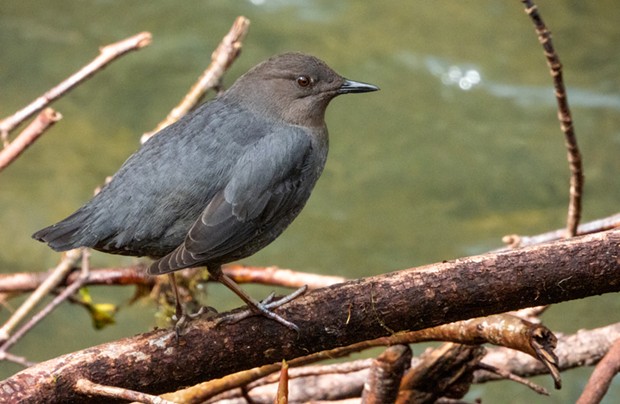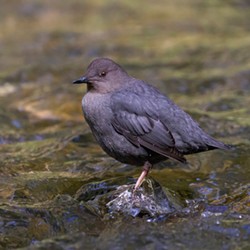[
{
"name": "Top Stories Video Pair",
"insertPoint": "7",
"component": "17087298",
"parentWrapperClass": "fdn-ads-inline-content-block",
"requiredCountToDisplay": "1"
}
]
After a heck of a winter, it's summer at last.
Now's the time to patch your roof, plant your garden (if you already have, you're way ahead of me) and explore Humboldt's diverse landscapes. Throughout the county, hidden gems await those of all abilities, whether at the end of an arduous hike or just up the road.
Maybe your travels will take you to a peaceful glen where tall trees filter the sunlight and a clear mountain stream splashes over smooth gray rocks, the burbling song of wild places. It's the perfect spot to pull up a camp chair and sit for a while, letting the melody of the water wash away the exigencies of modern life.
You might hear another song, too, a sweet, meandering duet with the tumbling water. A songbird, you'd think — and you'd be right. But this quirky songbird is unlike any other.
It's an American dipper, a bird naturalist John Muir called "the mountain stream's own darling ... a singularly joyous and lovable little fellow." The dipper is North America's only aquatic songbird, as at home in the water as other birds are in the sky.
Songbirds are known for their splashy colors, but the stodgy dipper is plain as a rock — in fact, it's easily mistaken for one as it forages along gravel bars near rushing streams, given away only by the nonstop bobbing for which it's named. Small and plump, it's covered in dull blue-gray feathers with a wash of brown on its head. A pattern of faint spots on its back furthers the illusion of a sun-dappled rock in the water.
But despite its no-frills packaging, the American dipper has a number of astonishing adaptations that allow it to live and thrive in fast-moving water. A dipper thinks nothing of diving into icy rapids and walking along the river bottom, turning over rocks as it goes to find insects, larvae and fish eggs. It can even swim underwater, propelling itself with its wings like a tiny torpedo.
How can a bird more closely related to a song sparrow than a mallard pull off these aquatic feats? For starters, that plain gray plumage is unusually dense, coated in oil and sheds water like a rain slicker. Special flaps close the dipper's nostrils when it's submerged — just like the nose plugs your mom made you wear to the pool as a kid — and a translucent third eyelid gives it underwater vision. This super-cool bird also comes with extra oxygen-carrying capacity in its blood coupled with a low metabolic rate. A thick layer of down next to its body insulates it from freezing temperatures.
Dipper nests, too, are feats of warmth-retaining engineering, constructed from many layers of moss and soft grasses to keep the interior toasty. A pair of dippers might even build their nest behind a waterfall, flying in and out through the curtain of water to feed their nestlings.
There's more to an American dipper than meets the eye, including eyelids lined with white feathers that flash when it blinks. Why? No one knows. And here's a fun fact: The collective term for dippers is, naturally, "a ladle."
But these fascinating birds need pristine moving water to survive, a resource that's in short supply these days. Where rivers are fouled by silt and toxins from logging, agriculture and development or warmed by climate change, dippers disappear. Like so many of our birds, their habitat is shrinking, and their numbers are in decline.
In Humboldt, though, there are still places where rivers run clear and cold. A few weeks ago, I found myself on a quiet dirt road north of Orick, where the trees were draped with moss and bashful varied thrushes scuttled off into the understory as I passed. I stopped at a noisy brook nearly overflowing its banks with icy spring runoff and found a spot to watch, wait and listen.
My patience was rewarded when I spotted a dipper perched on a fallen log above the torrent. It blinked, flashing those curious white eyelids. Without warning, it plunged into the water and vanished. A minute later, it popped up on a gravel bar 20 feet away with a fat larvae in its bill. Then with rapid wingbeats, it flew downstream, following the curve of the water until it was out of sight.
A moment later, a song rose above the chatter of the brook, exuberant warbles mixed with musical trills that flowed up and down the scale like the current itself. Even in song, dippers are different: Both males and females sing all year, or as Muir wrote, "For both in winter and summer he sings, sweetly, cheerily, independent alike of sunshine and of love, requiring no other inspiration than the stream on which he dwells."
This summer, especially, let's celebrate those qualities of the American dipper that we may also discover in ourselves: Our unique abilities, our quirkiness, our vital need for unspoiled wild places and crisp clean water, and whatever inspires us to sing the whole year round.
Sarah Hobart (she/her) is a freelance writer based in Humboldt County.
Speaking of Birding, American Dipper
-
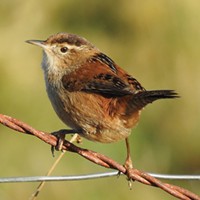
A Chime of Wrens
Apr 11, 2024 -
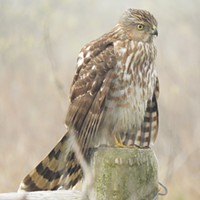
Bird Names for Everyone
Feb 29, 2024 -
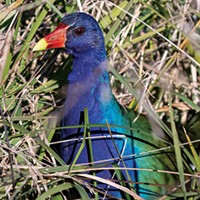
Spark Birds
Jan 11, 2024 - More »
Comments (3)
Showing 1-3 of 3
more from the author
-
A Chime of Wrens
- Apr 11, 2024
-
Bird Names for Everyone
- Feb 29, 2024
-
Spark Birds
- Jan 11, 2024
- More »
Latest in Get Out
Readers also liked…
-
A Walk Among the Spotted Owls
- Apr 27, 2023
